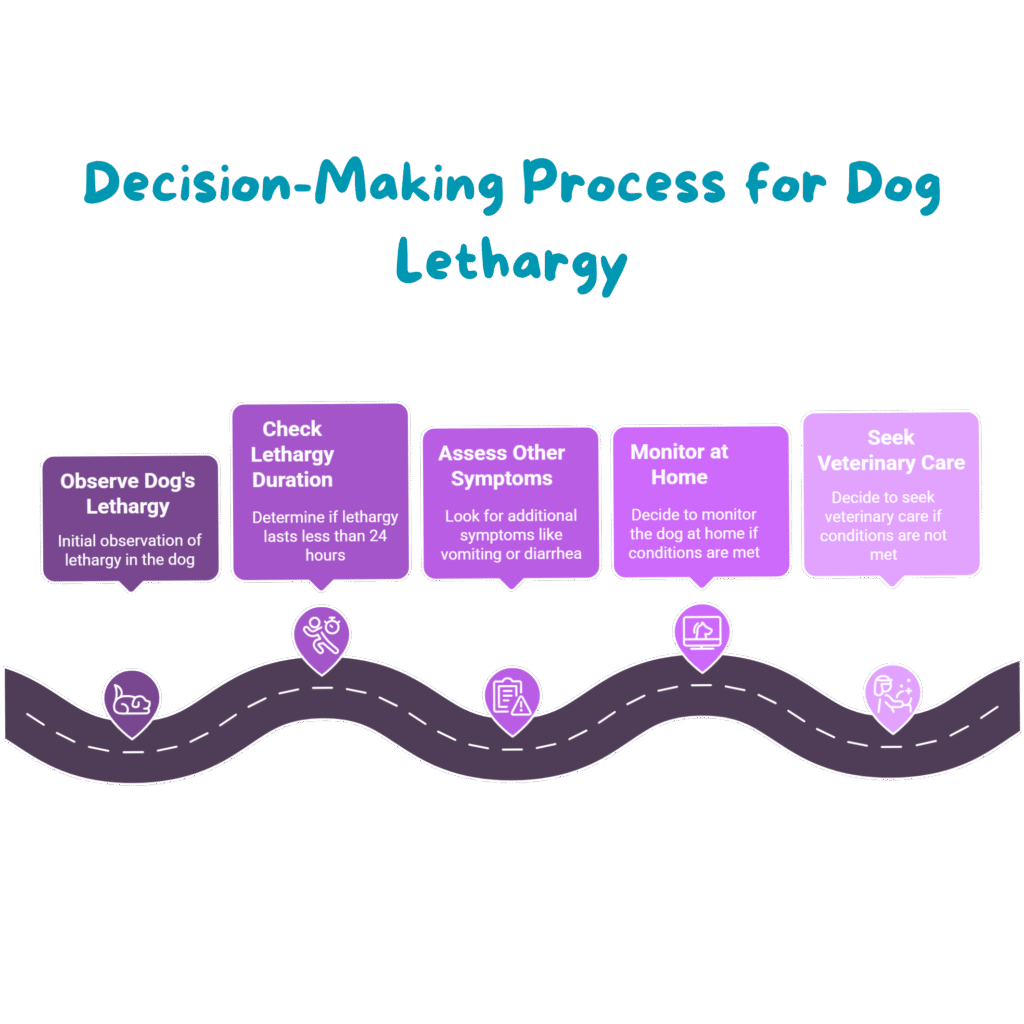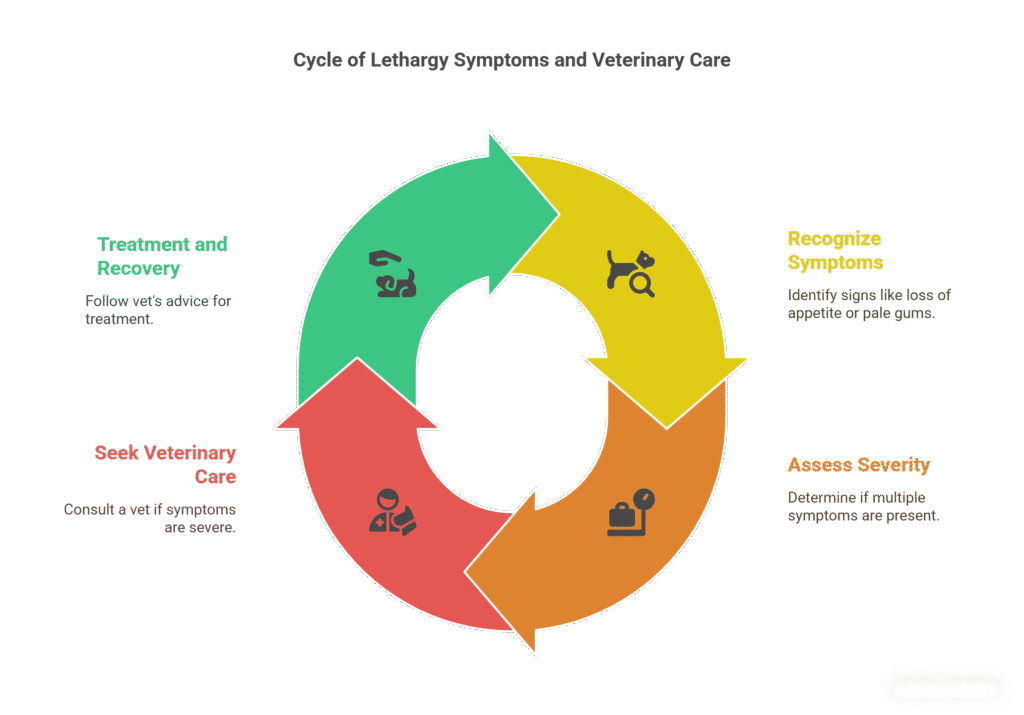If your normally energetic dog is now lethargic and not interested in playtime, you might be dealing with lethargy in dogs. While some fatigue is to be anticipated occasionally, persistent lethargy may be an indication of an underlying health issue.
This one-stop guide explores the causes, symptoms, and treatments of lethargy in dogs to help you know when it’s time to visit the vet.
What Is Lethargy in Dogs?
Lethargy in dogs is a peculiar condition of drowsiness, sluggishness, and weakness, which goes beyond normal fatigue. It’s a common symptom that can indicate various underlying health issues ranging from mild to serious. In contrast to a dog who’s resting after hard exercise, a lethargic dog remains consistently unenthusiastic about normal activities and play.

Key Characteristics of Lethargy in Dogs
A lazy dog will show clear behavioral and energy level changes, including:
- Over-sleeping (sleeping past normal meal times or when they should be up)
- Resistance to movement (will struggle going for a walk or not rising)
- Lack of interest (showing no interest in favorite toys, treats, or playtime)
- Slow responses (taking longer to react to their name or normal commands)
- Weakness or unsteadiness (appearing wobbly when walking or having trouble with stairs)
Differentiating Normal Fatigue from Concerning Lethargy
Normal tiredness must be differentiated from concerning lethargy:
| Normal Fatigue | Concerning Lethargy |
|---|---|
| Develops following exercise, play, or heat | Develops without apparent cause |
| Dog remains interested in food/water | Total lack of interest in food/water |
| Energy returns after rest | Ongoing low energy that continues 24+ hours |
| Normal response to stimuli | Slowed or absent response |
Duration and Severity Is Important
Lethargy may occur with different intensities:
- Mild lethargy (continues less than 24 hours with no other symptoms)
- Can be reversed with rest
- Can be due to minor issues like minimal dehydration or a sick night’s sleep
- Moderate lethargy (1-2 days’ duration or with minimal symptoms)
- May be a manifestation of infection, pain, or gastrointestinal problems
- Requires close observation
- Severe lethargy (persistent or with many symptoms)
- Usually reflects serious illness or emergent situations
- Requires immediate veterinary attention
Associated Symptoms to Watch For
While lethargy per se is alarming, these other signs are indications for even more urgency:
- Loss of appetite (not eating in 12+ hours)
- Vomiting or diarrhea
- Trouble breathing or coughing
- Pale or discolored gums
- Visible pain or discomfort
- Confusion or daze
- Fever or abnormally low body temperature
Common Causes of Lethargy
There are several things that can cause lethargic behavior in dogs:
Physical Health Issues
- Infections (viral, bacterial, or parasitic)
- Long-term medical conditions (kidney disease, diabetes, heart disease)
- Pain (from arthritis, injury, or internal disease)
- Anemia or blood disorders
- Neurological ailments
Environmental Causes
- Heat stroke or hypothermia
- New vaccinations (temporary lethargy is normal)
- Stressful situations (loud noises, new pets, moving)
- Malnutrition or dehydration
Toxicological Causes
- Ingestion of poison
- Medication side effects
- Toxic food intake (grapes, chocolate, xylitol)
When to Monitor vs. When to Act
Monitor at home if:
✓ The lethargy is mild and short-lived (<24 hours)
✓ No other concerning symptoms are there
✓ Dog is alert and drinking water
Seek veterinary care if:
✓ Lethargy lasts more than 24 hours
✓ Accompanied by vomiting, diarrhea, or loss of appetite
✓ Dog is having difficulty breathing or walking
✓ Suspected ingestion of toxic substances
✓ Underlying medical conditions

Initial Home Assessment
If your dog is lethargic but not distressed:
Eliminate access to potential toxins
Check gum color (should be pink, not pale or white)
Offer small amounts of water
Try tempting with favorite high-value reward
Take temperature if possible (normal is 101-102.5°F)
Take note of any recent change in environment or routine
Common Causes of Lethargy in Dogs
Dog lethargy can be attributed to numerous underlying causes, ranging from transient mild issues to critical medical emergencies. Being aware of these potential causes enables pet owners to recognize when their dog’s lethargy is of concern and should be seen by a veterinarian.
1. Illnesses & Infections
Bacterial or Viral Infections
- Parvovirus: Highly contagious viral disease causing extreme lethargy, vomiting, and bloody diarrhea (especially dangerous for puppies)
- Distemper: Serious viral illness affecting multiple body systems, with lethargy as one of the first signs
- Lyme Disease: Tick-borne bacterial illness causing joint pain, fever, and fatigue
- Kennel Cough: Respiratory infection leading to fatigue due to constant coughing
- Leptospirosis: Bacterial illness affecting kidneys and liver, leading to severe weakness
Fever-Related Lethargy
- Normally indicates the body is fighting infection
- May come with ear infections, urinary tract infections, or abscesses
- Dogs with fever typically present hot ears/dry nose and shaking
Chronic Illnesses
- Kidney Disease: Nausea and extreme fatigue from toxin buildup
- Diabetes: Blood sugar imbalances cause energy crashes
- Hypothyroidism: Underactive thyroid gland slows metabolism considerably
- Heart Disease: Reduced oxygen flow causes exercise intolerance
- Cancer: Tumors drain energy reserves and present systemic weakness
2. Injury or Pain

Arthritis & Joint Problems
- Older dogs slow down due to arthritic joints
- May shy away from jumping on furniture or going up stairs
- Stiffness following periods of rest are common
Acute Injuries
- Muscle tears or sprains from overexertion
- Fractures (not always externally evident)
- Spinal issues like IVDD (intervertebral disc disease)
- Post-surgical pain and medication adverse effects
Dental Pain
- Abscessed teeth or severe periodontal disease
- Refusal to eat hard food while appearing hungry
- Pawing at face can be observed with lethargy
3. Nutritional Issues & Dehydration
Diet-Related Problems
- Poor-quality food: Fails to supply nutrients for energy
- Sudden diet changes: Digestive disturbance and malaise ensue
- Food allergies: Chronic inflammation consumes energy
- Malabsorption disorders: Interfere with nutrient absorption
Dehydration Causes
- Insufficient water intake
- Excessive vomiting/diarrhea
- Kidney disease with fluid loss
- Hot climate with no shade/water
Vitamin Deficiencies
- Deficiency of B vitamin complex (encountered with poor diets)
- Iron deficiency anemia (lethargy is accompanied by pale gums)
- Electrolyte imbalances (especially potassium/sodium)
4. Environmental Factors
Heat-Related Problems
- Heatstroke: Life-threatening emergency causing severe lethargy
- Heat exhaustion: Mild heatstroke precursor
- Humidity intolerance: Especially in brachycephalic breeds
Stress & Anxiety Triggers
- Major routine changes: Change of homes, owner’s work schedule
- New household members: Babies, pets, or roommates
- Loud noises: Thunderstorms, fireworks, construction
- Separation anxiety: Can lead to depression-like behavior
Weather & Seasonal Effects
- Cold temperatures in short-haired breeds
- Changes in barometric pressure on joints
- Seasonal allergies leading to general malaise
5. Parasites & Toxins
Internal Parasites
- Roundworms/Hookworms: Anemia and nutritional theft
- Giardia: Intestinal parasite causing dehydration
- Heartworms: Late-stage causes exercise intolerance
Tick-Borne Diseases
- Lyme Disease: Already mentioned
- Anaplasmosis: Causes joint pain and fever
- Ehrlichiosis: Causes bleeding disorders and lethargy
Toxic Substances
- Food toxins: Chocolate, grapes, xylitol, onions
- Household chemicals: Antifreeze, rodenticides, cleaners
- Human medications: NSAIDs, antidepressants, ADHD medications
- Plants: Lilies, sago palms, oleander
- Insecticides: Flea/tick product overdoses
Less Common But Serious Causes
- Autoimmune diseases: Attacking the body’s own cells
- Neurological disorders: Seizures, vestibular disease
- Endocrine disorders: Addison’s disease, Cushing’s
- Organ failure: Liver, heart, or kidney shutdown
- Blood disorders: Immune-mediated hemolytic anemia
Every potential cause requires different tests and treatments. The duration and severity of lethargy and the accompanying symptoms direct veterinarians on which tests to run and how urgently. Even mild lethargy lasting longer than 24-48 hours should be evaluated by a veterinarian to rule out developing health issues.
Symptoms That Go Along with Lethargy

Lethargy rarely happens alone. Watch for the warning signs:
Loss of appetite – Skipping food for more than 24 hours
Vomiting or diarrhea – Can be a sign of poisoning or infection
Labored breathing – May signal heart or lung disease
Pale gums – Signs of anemia or internal bleeding
Excessive thirst/urination – Either kidney disease or diabetes
Should your dog suffer more than one symptom, seek vet attention immediately.
Diagnosing the Underlying Cause
Vets use several methods to determine the reason for dog lethargy:
Physical exam (temperature, pulse, hydration)
Blood tests (detecting infection, anemia, disease of organs)
Urinalysis (detecting kidney disease or diabetes)
Imaging (X-rays or ultrasounds for trauma or tumors)
Receiving an early diagnosis improves the effectiveness of treatment!
Treatment Options for Lethargic Dogs
Treatment varies with the underlying cause:
Medications – Antibiotics for infections, pain medications for arthritis
Fluid therapy – In the case of dehydration or kidney disease
Diet changes – Transition to high-quality, vet-recommended food
Surgery – In cases of lethargy caused by a tumor or internal trauma
Home Care Tips:
- Ensure constant access to fresh water
- Promote gentle exercise (short walks)
- Place your dog in a calm, stress-free setting
How to Avoid Lethargy in Dogs
Prevention is better than cure! Here are the steps to follow:
✔ Eat a balanced diet (ask your vet for suggestions)
✔ Provide regular exercise (appropriate for age and breed)
✔ Stay current on vaccinations & parasite control
✔ Watch for stress cues (new pets, noises)
✔ Make yearly vet visits
Conclusion
Canine lethargy can be due to minor or serious health problems. While rest can be helpful in mild cases, chronic fatigue—especially with other symptoms must be treated by a veterinarian.
If your pet is unusually tired, monitor closely and see your vet if the situation gets worse. Early action can save your pet’s life!

Dr.Vala Siddharajsinh Raysinhbhai is a certified Animal Husbandry Technician, holding a diploma from Kamdhenu University, India. His expertise covers livestock breeding, nutrition, disease control, and animal welfare. Passionate about rural veterinary care, he actively contributes to animal health awareness and sustainable livestock management through both fieldwork and educational content.





